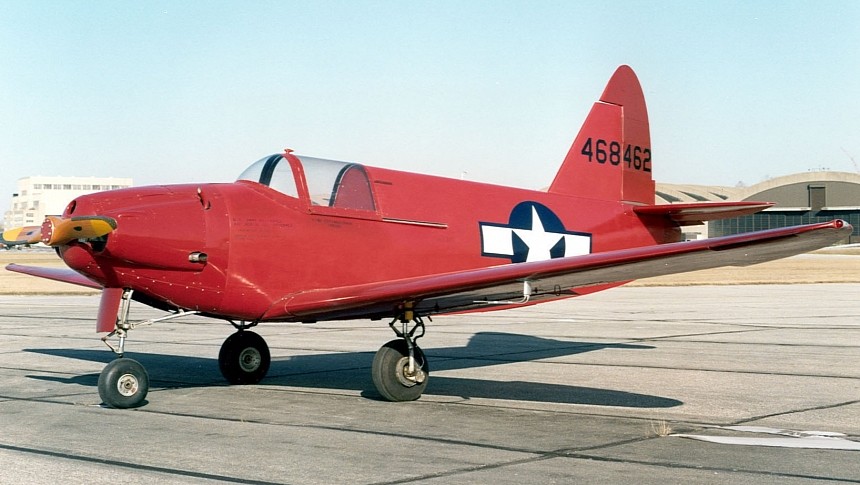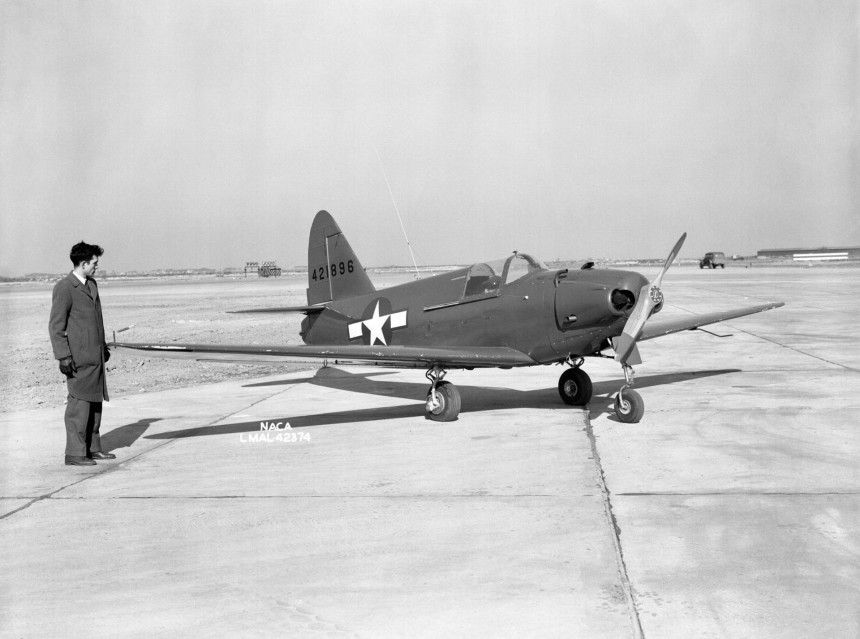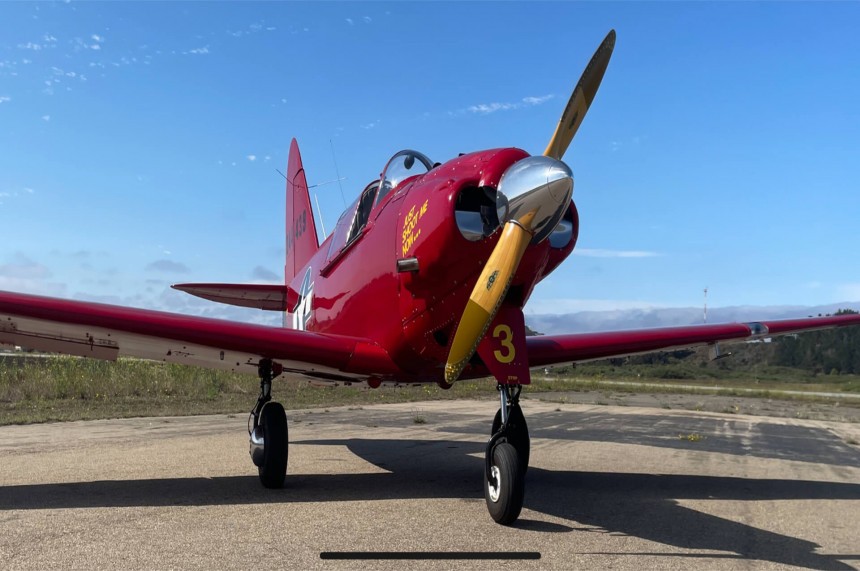It's not often we find a Second World War warbird we've straight up never heard of before. Between all the War Thunder updates and the treasure trove of YouTube channels dedicated to covering WWII aviation, it's easy to think you've seen it all after a while. That's why the Culver PQ-14 Cadet is such a curiosity. This little RC target drone, built to maneuver more-or-less like a full-fledged fighter plane, is so pleasing on the eyes you'd almost feel bad emptying four drums .50 BMG into one. But that's what this pint-sized plane was built to do.
It took a little digging to tell the full story behind the PQ-14. But it all falls back to a little-remembered maverick of aviation's late pioneer era named Albert W. "Al" Mooney. Mooney might be one of the lesser-known aero engineers in the time after the Wright Brothers, Glenn Curtiss, and the other originators of human-crewed flight as a whole had all died or retired. But the former railroad worker with a rail-tunnel engineer for a father came from a background that set him up nicely for a career in the clouds.
The Denver native dropped plans to attend engineering college focusing on mining to study aviation when he saw a Swallow Airplane Company biplane fly over his head as a teenager. By the age of 19, Mooney was working alongside the chief engineer at the Alexander Aircraft Company in Denver. By 1929, Al Mooney and his brother Arthur had founded the Mooney Aircraft Company. Today, the company is still in business in its second iteration as the Mooney International Corporation. It's through Al Mooney's early work, like the prototype M-5, that he gained a reputation for a trademark teardrop silhouette in his designs.
By the turn of the decade, Mooney's airplanes were making nonstop flights from Glendale, California, to Long Island, New York, for promotional material to maintain public interest in aviation during the Great Depression. But this alone couldn't steel against the tide of global economic ruin that befell the world at the time, and the first iteration of the Mooney company closed down in 1931. This left Al and his brother in a state something like a high-class free agent in a sports league, free to go to a company of their choosing, assuming the conditions were right.
Though not the first stay on his all-star tour working for America's elite aviation firms, Al Mooney worked with his business partner Knight K. Culver to found the Dart Aircraft Company, which was renamed the Culver Aircraft Company in 1939. Culver's first product, the Dart, was itself a remanufacturing of the Lambert Aircraft Corporation's Monosport G light monoplane. Over time, the Culver Dart's basic design was improved and upgraded into an all-new aircraft called the PQ-8 Cadet.
With the now unmistakable teardrop-shaped airframe and low-slung, mono-wing layout native to Mooney's designs, the PQ-8 was regarded as a phenomenal aircraft to fly. With a peppy 80-hp Franklin 4AC air-cooled, flat-four under the hood, the original Cadet was like a Mazda Miata with wings. Its handling characteristics were so favorable that even the U.S. Navy and Army Air Corps came knocking at Culver's door, asking if they could build an upgraded version for military service. At the end of this deceptively long Mooney family tree were the results of the U.S. Military's request, the PQ-14.
With the same lovely shape as the civilian PQ-8 but with a larger 19-foot, six-inch (5.94 m) long airframe and a bigger six-cylinder Franklin engine, the PQ-14 was perfect for the USAAC's groundbreaking experiments with radio-controlled target drones. The first PQ-14 was a converted PQ-8, which first flew in 1942, sporting an all-new retractable landing gear instead of the PQ-8's fixed gear system. By filling the cockpit with mechanically actuating, remotely operated controls, Army Air Corps trainees could get their first taste of gunning down enemy aircraft without the usual casualties such an act would entail.
While being controlled by a nearby mothership, typically a Beechcraft Model 18 variant of some sort, the vast majority of the PQ-14's 2000-plus example production run converted to flaming piles of scrap by Army Air Corps pilots and trainee Army anti-aircraft (AA) operators. How anyone would want to shoot down a plane as pretty as the Cadet, especially with its awesome red target drone paint, is beyond us. But when the prize is a spin in an Army Air Corps P-51 Mustang or a Navy F4U Corsair, one can only assume the ends justify the means. But seriously, that red paint is so nice, you could take off all the USAAC roundels and slap a Ferrari badge on a PQ-14, and we'd believe you if you said it was Old Man Enzo's daily flyer.
Though most Cadets were turned to paste during the war, a few managed to linger around even after the USAAC became the U.S. Air Force when they were put on surplus in 1950. When civilians got their hands on surplus PQ-14s, pilots rejoiced at its agile handling characteristics, attributed to its rather fighter-like, low-wing design and its relatively powerful six-cylinder engine.
Today, at least eight PQ-14 airframes remain on display or in storage in museums across the United States. With one airworthy example in the collections of the Planes of Fame Air Museum in Chino, California, and two more in the hands of private collectors in Colorado Springs, Colorado, and Big Bear, California, respectively. You don't need us to tell you how lucky those two are.
The Denver native dropped plans to attend engineering college focusing on mining to study aviation when he saw a Swallow Airplane Company biplane fly over his head as a teenager. By the age of 19, Mooney was working alongside the chief engineer at the Alexander Aircraft Company in Denver. By 1929, Al Mooney and his brother Arthur had founded the Mooney Aircraft Company. Today, the company is still in business in its second iteration as the Mooney International Corporation. It's through Al Mooney's early work, like the prototype M-5, that he gained a reputation for a trademark teardrop silhouette in his designs.
By the turn of the decade, Mooney's airplanes were making nonstop flights from Glendale, California, to Long Island, New York, for promotional material to maintain public interest in aviation during the Great Depression. But this alone couldn't steel against the tide of global economic ruin that befell the world at the time, and the first iteration of the Mooney company closed down in 1931. This left Al and his brother in a state something like a high-class free agent in a sports league, free to go to a company of their choosing, assuming the conditions were right.
Though not the first stay on his all-star tour working for America's elite aviation firms, Al Mooney worked with his business partner Knight K. Culver to found the Dart Aircraft Company, which was renamed the Culver Aircraft Company in 1939. Culver's first product, the Dart, was itself a remanufacturing of the Lambert Aircraft Corporation's Monosport G light monoplane. Over time, the Culver Dart's basic design was improved and upgraded into an all-new aircraft called the PQ-8 Cadet.
With the same lovely shape as the civilian PQ-8 but with a larger 19-foot, six-inch (5.94 m) long airframe and a bigger six-cylinder Franklin engine, the PQ-14 was perfect for the USAAC's groundbreaking experiments with radio-controlled target drones. The first PQ-14 was a converted PQ-8, which first flew in 1942, sporting an all-new retractable landing gear instead of the PQ-8's fixed gear system. By filling the cockpit with mechanically actuating, remotely operated controls, Army Air Corps trainees could get their first taste of gunning down enemy aircraft without the usual casualties such an act would entail.
While being controlled by a nearby mothership, typically a Beechcraft Model 18 variant of some sort, the vast majority of the PQ-14's 2000-plus example production run converted to flaming piles of scrap by Army Air Corps pilots and trainee Army anti-aircraft (AA) operators. How anyone would want to shoot down a plane as pretty as the Cadet, especially with its awesome red target drone paint, is beyond us. But when the prize is a spin in an Army Air Corps P-51 Mustang or a Navy F4U Corsair, one can only assume the ends justify the means. But seriously, that red paint is so nice, you could take off all the USAAC roundels and slap a Ferrari badge on a PQ-14, and we'd believe you if you said it was Old Man Enzo's daily flyer.
Though most Cadets were turned to paste during the war, a few managed to linger around even after the USAAC became the U.S. Air Force when they were put on surplus in 1950. When civilians got their hands on surplus PQ-14s, pilots rejoiced at its agile handling characteristics, attributed to its rather fighter-like, low-wing design and its relatively powerful six-cylinder engine.













